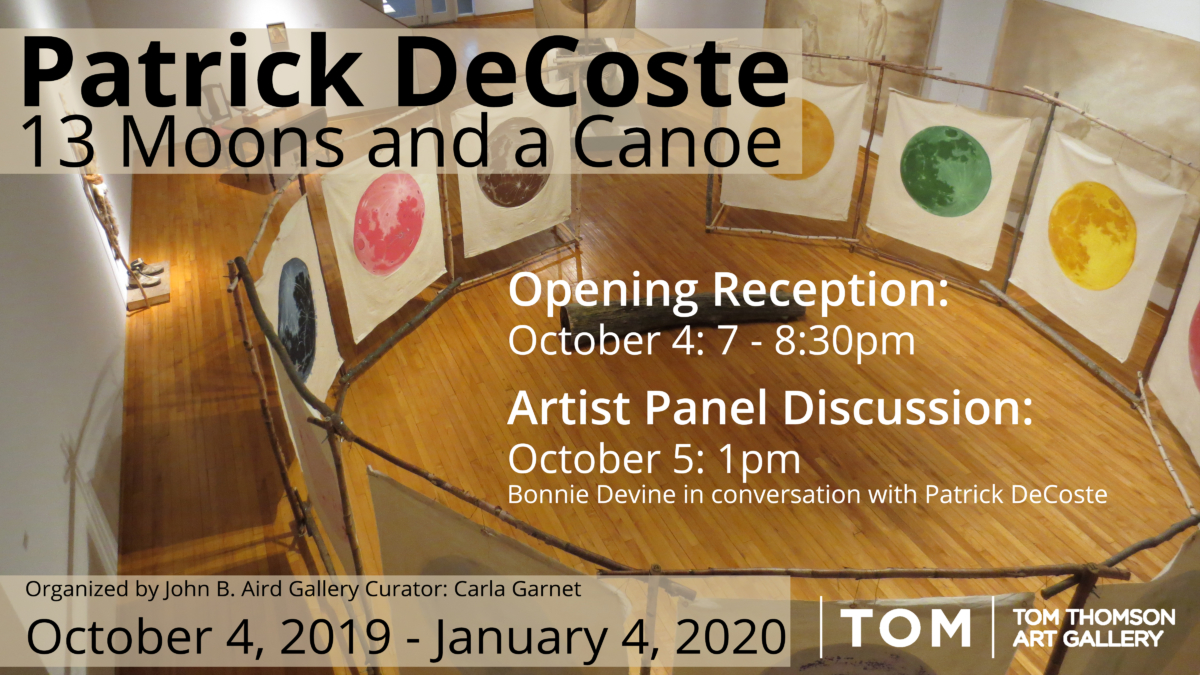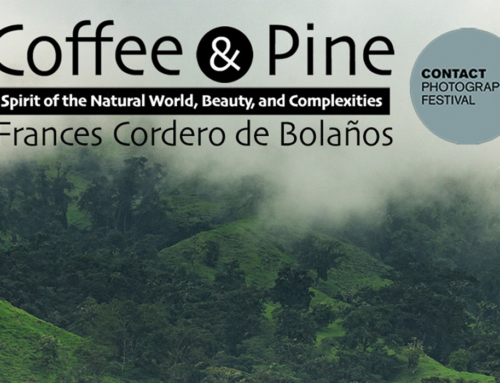Organized by the John B. Aird Gallery
Guest Curated by Carla Garnet Essay contribution from Bonnie Devine
Exhibition funded by Indigenous Art Project Grants from Ontario Arts Council and the Toronto Arts Council
Patrick DeCoste is an award-winning Toronto-based visual artist who studied fine arts at Mount Allison University. He has exhibited extensively in Toronto, as well as New York City and beyond. The Globe and Mail calls him ‘a young old master’ and Los Angeles writer Chris Kraus in C-Magazine describes his painting as ‘heroic and musty, strange and disturbing’. He was awarded a Chalmers Arts Fellowship in 2011.
Through his art he explores Indigenous histories and his Nova Scotia Métis roots. In 2014, he received the President’s Award for Outstanding Achievement in Graduate Studies from OCADU, where he completed an Interdisciplinary MFA. His recent exhibitions include solo exhibitions at Galerie Youn, Montreal 2014; Station Gallery, Whitby 2015. This past year DeCoste was awarded grants from The Canada Council for the Arts for the production of new works, from The Ontario Arts Council’s Aboriginal Artists in Schools program and from the Toronto Arts Council for his 13 Moons and A Canoe exhibit. When not in the city, Patrick spends time at his studio on Georgian Bay, near Lafontaine, canoeing with his dog Luca, and making art in the forest.
Thanks to community supporter Grey Roots Museum & Archives for all loans included in exhibition. Patrick DeCoste would like to acknowledge his appreciation and thanks to the Tom Thomson Art Gallery staff, Director/Curator Carla Garnet of John B. Aird Gallery in Toronto, Ontario and writer Bonnie Devine. Thanks to the Ontario
Arts Council and the Toronto Arts Council for funding support of this exhibition.
Introductory Essay
by Carla Garnet, Guest Curator
Patrick DeCoste: 13 Moons and A Canoe is an interdisciplinary art exhibition exploring the artist’s emerging Métis identity. The main components of the show are a canoe and a circular room.
The exhibition and the dialogue it fosters are offered in the spirit of advancing ongoing conversations about Canadian identity, and how together we might take responsibility for our past, present, and future. In the works that comprise 13 Moons and a Canoe, DeCoste takes up history as something living and breathing, the conceptual weight of his work lightened by its rich materiality. The installation pairs a canoe, retrofitted with a mast and sail, with a circular room made up of thirteen walls – each wall, with exception to a doorway that is left open is adorned with a canvas that is painted with a large, colourful moon – strung across poles hewn from forest trees.
This room-within-a-room evokes a pastiche of environmental, cultural, and personal influences. It is, on the one hand, a monument to the Indigenous lunar calendar, an inner sanctum delineated by the full moons that mark the passing of each year, and, on the other hand, a kind of family portrait for the artist; the twelve walls represent DeCoste and each of his eleven siblings. The modified canoe, reveals the thirteenth moon on its sail, this white moon represents the baby who did not survive, the thirteenth child.
The canoe sits outside the tridecagon room; it conjures up the genesis of the Métis people in seventeenth-century Nova Scotia, where DeCoste’s family has its roots. It is a potent symbol of First Contact between Europeans and Indigenous peoples – a hybrid object, deceptively quaint in appearance that literalizes the impact of cultures quickening against and into one another.
For DeCoste, themes of journeys, maps, meetings, and cultural exchange resonate on a personal level as he draws on these concepts to map out his own positionality and identity. The work is not so much a critique of colonialism as an attempt to grapple with the forces of history, culture, family, and identity as they relate to his own experience as a contemporary Métis artist with Nova Scotian roots, living and working in Toronto and Georgian Bay.
The exhibition also includes a series of acrylic paintings on polar bear, spirit bear, and other animal skins, along with paintings and studio objects that reflect DeCoste’s journey toward understanding (and fully inhabiting) his Métis identity. The paintings exuberantly meld cultural and highly personal symbolism with dreamlike imagery, alluding to the story of a dream that a young Mi’kmaw woman had over 500 years ago – of a bearded white man standing on an island floating toward her shore, foretelling the arrival of Europeans on the First People’s lands. DeCoste’s journey of self-knowledge is mirrored in this vision of First Contact as he maps his own experience onto the history that his works evoke.
Carla Garnet—Biography
Carla Garnet is the John B. Aird Gallery Director/Curator and JOUEZ curator for the annual BIG On Bloor Festival of Arts and Culture in Toronto. Garnet is on the Trinity Square Video Board of Directors where she is active on both the program and fundraising committees. She has worked as in-house curator at the Art Gallery of Peterborough (2010-2013), as guest curator at Gallery Stratford (2009-2010), as an independent curator (1997-2010) and as the founder and director of Garnet Press Gallery (1984-97). While at the Art Gallery of Peterborough, in addition to her curatorial work, she developed and managed the gallery’s education program. Garnet holds an Associate Diploma from the Ontario College of Art and Design and a Masters Degree in Art History from York University.
Garnet is interested in the politics of the art exhibition and its potential to function as a common—a public space for dialogue. Her curatorial area of interest engages with an exploration of work that presents the possibility of existing simultaneously in many tenses or occupying more than one subject position at once, or both as way to open up a space for greater empathy. For Garnet, an artwork’s significance is tied up with an ability to say what otherwise might be unsayable. She notes that DeCoste’s recent body of work premised on an historical event/myth relates an encounter, which sets into motion what can happen, when people exchange cultures, mix, and become the Métis.
A House Made of Moon
Essay by Bonnie Devine
Since earliest times humankind has marvelled at the great celestial lamps in the sky, the sun during the day and the stars and moon at night. In many places on Earth the ancient ones moved giant stones into circles to mark the slow oscillating trail of the sunrise on the horizon and used the monumental wheels thus created to predict the start of the seasons – the long days of summer and the short grey winter days. Using the ply of the sun’s orbit on the far edge of the earth we wove the passage of thousands of years into a long undulating ribbon of time.
In the stars we saw stories. Here a hunter intent on the chase, there a great winged serpent curled across an enormous swath of sky. We gave these beings names and used their patterns as an astral bestiary to navigate, plant crops, and prophesy. In the northern hemisphere we use the Polestar to determine latitude and direction at sea and on land. In the southern hemisphere, where no single mighty star dominates the night, dark cloud constellations form compelling silhouettes of animals that the Inca regard as living souls come to drink at the celestial river. That river, whose contour is formed of millions of stars, is the rim of a magnificent vortex – our own galaxy, the Milky Way.
Our Moon is four hundred times smaller and much less bright than her brother the Sun but she is also four hundred times closer to Earth, and because of this mysterious counter-equivalence of distance and magnitude she appears to be the same size as the Sun in our sky. The one face she shows us beams down with reflected sunlight so dim she is clearly visible only at night and as she waxes and wanes through the twenty-nine day lunar month she provides us with our second celestial time-keeping device – a visible reminder, like the ocean’s tides and the body’s tides, that in the monstrous flux of change and transformation that is our mortal fate, a unifying and reassuring pattern remains. A device for counting, a slowly beating clock, a natural calendar … the Anishinaabek call her Nokomis, Grandmother, and observe her cycles as the markers of the thirteen seasons of the lunar year.
Anishinaabe Names of the Moon
January 23 Manidoo-giizis (Spirit Moon) February 22 Mkwa-giizis (Bear Moon)
March 23 Onaabdin-giizis (Snowcrust Moon)
April 22 Iskigamizige-giizis (Sugarbush Moon)
May 21 Zaagibagaa-giizis (Budding Moon)
June 20 Odemiini-giizis (Strawberry Moon)
July 19 Abitaa-niibini-giizis (Halfway Summer Moon)
August 18 Manoominike-giizis (Rice Gathering Moon)
September 16 Waatebagaa-giizis (Turning Leaves Moon)
October 16 Binaakwe-giizis (Falling Leaves Moon)
November 14 Gashkadino-Giizis (Freezing Over Moon)
December 13 Manidoo-Giizisoons (Little Spirit Moon) (1)
Here on Earth the sacred turtle’s shell is fashioned of thirteen plates to represent the thirteen months and an encircling skirt of 28 smaller platelets for the 28 days of the lunar month, as if to reflect in one lucid sign the meaning of the moon’s relationship to time.
In Defense of the Unfinished Edge
Thirteen portraits of the full Moon are central figures in Patrick DeCoste’s installation, painted on the thirteen sides of the circular lodge he has created and placed in the middle of the gallery. Nokomis’s thirteen faces are painted on loose, unstretched, raw canvas panels; her repeated countenance turned outward to us, so that we look inward to her, an experiential reversal that locates her at the fulcrum, not the outer rim, of our body’s compass. We move around the circle of her portraits slowly, performing in reflection a miniature facsimile of her orbit around Earth, a revolution that takes her thirteen months but takes us a brief ten-minute circuit to accomplish – a year of moons in a moment’s turn, a cycle of seasons in a stroll round the gallery. The symbolism is straightforward perhaps, yet also disorienting: to look into the centre and yet outward to the sky simultaneously, to consider the geometry and the physics that govern her path and see that they direct our own, to awaken ourselves to our own little movements, our selves as bodies in space and time, akin in some ancient way under the Moon’s limpid silent gaze.
The lodge is a sacred containment in many Indigenous traditions. Fundamentally feminine, its rounded frame emphasizes the maternal source, the watery crucible from which all animate beings emerge. It is a house in its most prosaic form, and so DeCoste’s decision to name his thirteen painted moons after his siblings and create a family abode confirms and anchors the premise of his installation, establishing a circle of affinity and relation in blood and allegory that begs us to enter. But the familial domesticity of Decoste’s lodge could not be less familiar. What manner of house has walls of such tenuous materiality? Where would a dwelling so delicately constructed dare to stand? Could it be an imaginary home for the displaced Indigenous nations of this country, a home raggedly, hastily, provisionally built just as our ancestors built their tarpaper shanties on the edges of Canada’s new domain? A home circling in the cold of Earth’s orbit, on the fringe of Earth’s vision, at the edge of the habitable world.
It is hard not to see references to DeCoste’s East Coast Métis heritage reflected in the house he has built.
In Canada, a Métis citizen is distinct from a person who claims First Nation, Inuit and non-Aboriginal status. A Métis is a person of mixed blood; specifically: a person of European and North American Indian Ancestry, regardless of how many generations back (i.e. a person who is not entitled to registry through the Indian Act), a person who Self Identifies and is accepted by the Community. (2)
The Métis are the only the Indigenous group in Canada with no homeland. Early Métis worked as coureurs des bois whose range of activity spanned the river-folded forests of the Canadian Shield, or farmers who scraped a subsistence out of the vast prairie lands of the central plains, or fishers who clung to the Acadian and Cajun territories of the Eastern Seaboard. The frayed canvas edges of DeCoste’s lunar panels speak of penury, haste, and transience. Landless, many Métis settled on the unused verges of land on either side of the roadways that soon began to thread across the face of this country. These government-owned road allowances were thirty-foot wide strips of dirt classified as Crown land that were reserved by the state to accommodate future new roads. (3) While they were unused and unoccupied these scraps of land were open to squatters (read: Métis) until such time as construction teams could move in to build the highway. (4)
A History of Meaning
Yet despite its makeshift appearance, DeCoste’s house made of Moon offers a subtle but unmistakeable impression of renewal and vigour, derived from and modelled on the Moon’s apparent cyclical regenerative power to revive, reconstitute, and rebirth herself as she circles through her phases. More ominously, NASA is currently conducting research into the Moon’s material, commercial, and energy resources whose most recent work includes the design of a ‘lunar solar wind volatiles extraction system’. NASA’s focus is on sourcing and transporting hydrogen, water, carbon dioxide, and helium-3 from the Moon to the Earth. (5) Yes, the Moon is a treasure trove. The Moon is a mystical generator. The Moon is Nokomis, our grandmother.
Located outside DeCoste’s shelter of lunar panels lies a canoe. Delicately ribbed, sturdily sheathed, painted green. The Anishinaabek perfected the technology, design, and construction of the traditional birchbark canoe long centuries ago. It was
…the principal means of water transportation for the Aboriginal peoples of the Eastern Woodlands, and later for voyageurs, who used it extensively in the fur trade in Canada. The birchbark canoe was light, manoeuvrable, and perfectly adapted to summer travel through the network of shallow streams, ponds, lakes, and swift rivers of the Canadian Shield. …
They were a necessity for nomadic northern Algonquian peoples, the Innu (Montagnais-Naskapi), Ojibwa, Maliseet and Algonquin. After sustained contact with Europeans, voyageurs used birchbark canoes to explore and trade in the interior of the country, and to connect fur trade supply lines with central posts, notably Montréal. (6)
Known for its elegance and speed, the canoe expedited the settlement of Canada by carrying goods, arms, and people far into the interior of the continent, sustaining the nation’s westward expansion and opening up the land. DeCoste’s canoe is slim and phallic, its iconic contour interrupted by a jaunty mast and makeshift sail. Like the house made of moon, DeCoste’s canoe is laden with meaning and layered with history.
French interest in the New World began in 1524 when Francis I sponsored an expedition to explore and chart the region between Florida and Newfoundland, seeking a route to the Pacific Ocean. Although the English had laid claim to the region as early as 1497 when John Cabot landed in what is now Newfoundland or Nova Scotia, these claims were not exercised until Jacques Cartier planted a cross for France in the Gaspé Peninsula in 1534.
Permanent settlements established at Charlesbourg-Royal in 1541, at Sable Island in 1598, and at Tadoussac, Quebec in 1600 all eventually failed, but French fishing fleets sailed the Atlantic coast and the St. Lawrence River, trading and making alliances with First Nations. (7)
DeCoste’s canoe with a sail recalls in satiric, deadpan fashion the advent of European explorers in Eastern Canada and the violent interaction with Indigenous people and traditions that occurred there. The old ways failed in a brutal period of conflagration, integration, and synthesis. New customs emerged, new methods were born to cope with tumultuous change, new hybrid technologies and new hybrid peoples, yes peoples, conceived in the ruthless and passionate penetration of the new world.
There was a house made of dawn, it was made of pollen and rain.
~ N. Scott Momaday (8)
When Momaday, a Kiowa poet, wrote these words in his 1968 novel House Made of Dawn, critics hardly knew how to react to his alien voice. In those days Momaday’s protagonist, a broken down Indian struggling to find meaning after World War ll, didn’t ring true – the subject matter seemed more like social commentary than artistic achievement. The book was also criticized for Momaday’s literary mannerisms; his lyrical style seemed florid, laboured, stilted, and unoriginal. Some opined that Indigenous myth, legend, and culture could not help but suffer if translated into a traditional Western literary form like the novel.
But more thoughtful commentators understood the value of Momaday’s brave foray into mainstream cultural production and in the end House Made of Dawn was recognized for the literary achievement it was and awarded the Pulitzer Prize for fiction in 1969. In the process the novel opened the way for a generation of Indigenous writers and artists with stories to tell, and ushered in a new age in Indigenous North American fiction.
We need our stories.
The Métis struggle for a homeland, the Anishinaabek’s work to bring meaningful treaty acknowledgement to the land and waterways we love, and the Haudenosaunee battle to prevent further deterioration of ancestral territories under threat are much in the news in this year of reconciliation, truth, and the celebration of Canada’s 150th birthday. As I write this paper, DeCoste’s house of thirteen Moons is not yet built. Yet it already occupies a space in my imagination, has staked out a future in my memory, is waiting for me to walk in.
We need our stories.
(2017)
(1) http://ojibwe.net/projects/months-moons/ accessed September 20, 2017
(2) http://easternwoodlandmetisnation.ca/main.htm accessed September 20, 2017
(3) http://www.ammsa.com/publications/ontario-birchbark/road-allowance- peoples-history-shared-toronto accessed September 20, 2017
(4) http://www.metisfamilyservices.ca/metis-culture/metis-history accessed September 20, 2017
(5) https://www.nasa.gov/feature/harnessing-power-from-the-moon accessed September 23, 2017
(6) http://www.thecanadianencyclopedia.ca/en/article/birchbark-canoe/ accessed September 19 2017
(7) Margaret F. Pickett; Dwayne W. Pickett (2011). The European Struggle to Settle North America: Colonizing Attempts by England, France and Spain, 1521–1608 Pp 58-61
(8) Scott Momaday, House Made of Dawn. Harper Perennial Modern Classics; Reprint edition (April 13 2010), originally published by Harper and Row, New York, 1968
Bonnie Devine—Biography
Bonnie Devine is an installation artist, curator, writer, and educator, and a member of the Serpent River First Nation of Northern Ontario (Anishinaabe/Ojibwa). She is an Associate Professor and the Founding Chair of OCAD University’s Indigenous Visual Culture Program. As an independent curator, she has worked with emerging and established Indigenous artists since 1997, and she curated and organized “The Drawings and Paintings of Daphne Odjig: A Retrospective Exhibition,” which was the first solo exhibition by a female Indigenous artist at the National Gallery of Canada. Devine’s work has been recognized with numerous scholarships and awards, including an Eiteljorg Fellowship for Contemporary Native Art in 2011.
Professor Devine has taught studio and liberal arts courses at York University, Queen’s University, and the Centre for Indigenous Theatre. She has been a full-time instructor at OCAD University in the Faculty of Art, the Faculty of Liberal Arts and Sciences, and the School of Interdisciplinary Studies since 2008. In her role as the Founding Chair of OCAD U’s Indigenous Visual Culture program, Devine has developed curriculum, taught classes, built ancillary programming, and developed student services to support OCAD’s growing population of Indigenous students and provide a critical Indigenous perspective within the art and design academy.
Devine holds fine art degrees in sculpture and installation from OCAD and York Universities. Her work has been recognized with numerous scholarships and awards, including an Eiteljorg Fellowship for Contemporary Native Art in 2011.
Métis Mapping by Patrick DeCoste, 2018
During my childhood, my family never spoke of being Métis. When my father died, my mother showed me our family tree and pointed to Marie-Therez, a Mi’kmaw woman, who married Claude Petitpas, a French settler in Port Royal, Nova Scotia, in the 1600s. Their Métis children, along with other Métis families, lived harmoniously with the Acadians (French) and Mi’kmaq for many generations. When the British arrived in the 1700s they put a bounty on the scalps of Mi’kmaw men, women, and children, from 1749-1752. They also proclaimed it illegal for Acadians to consort with Mi’kmaq, and soon after, expelled 10,000 Acadians. Any Acadians or Métis who avoided death or expulsion, headed to the hills, and in the case of my relatives, to Cape Breton.
This is my Métis history.
The Mi’kmaq endured brutal colonization under the British, which continued under the Indian Act and the residential school systems of the government of Canada. Against these odds, the resilient Mi’kmaq have managed to preserve their language and customs. Acadian culture has also survived, while Métis culture was metaphorically and literally hiding in the hills. Not until the year 2000 did the Eastern Woodland Métis Nation of Nova Scotia incorporate.
This is my Métis history.
Though my Métis awareness and identity arrived in my adult years, I now realize that some of my childhood activities were strongly related to Métis culture – fiddle music, step-dancing, cuisine, and methods of hunting, to name a few. I have since gone back home to Nova Scotia from Toronto, with a new perspective, exploring my heritage through pow wows, concerts, museums, historical sites, family, and friends. In 2014, I returned to university and completed a Master’s degree in Fine Arts, where I focused on my Métis identity.
This is my Métis history.






